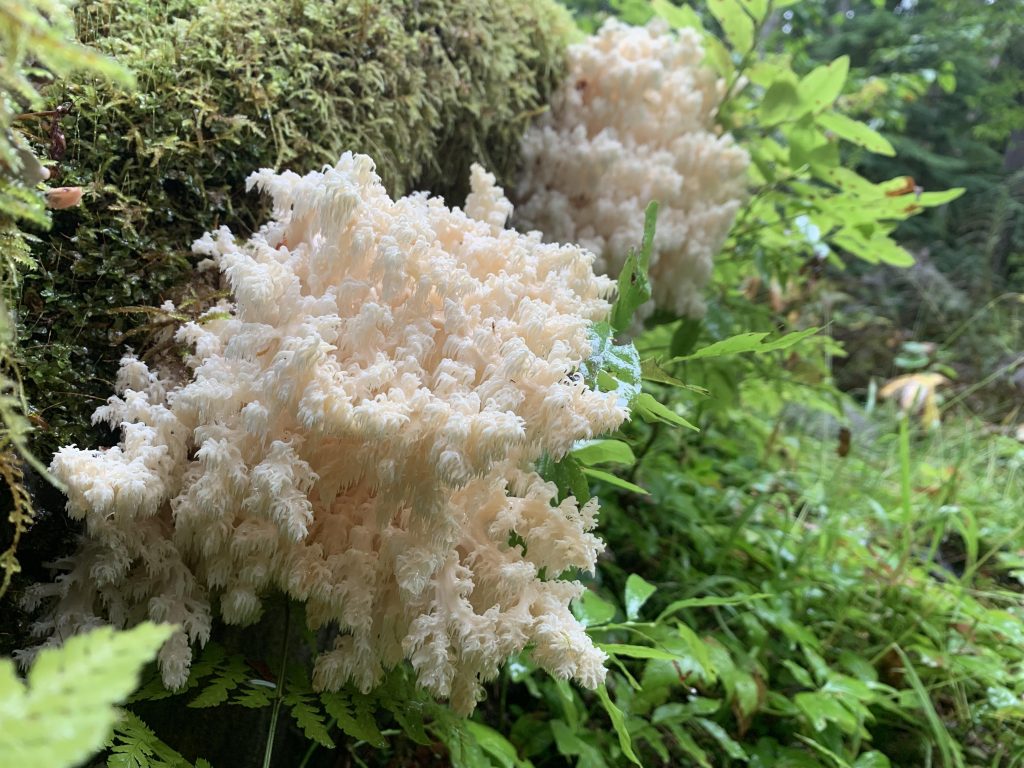- abietis, the bear’s head mushroom, is a close relative of lion’s mane (H. erinaceus), a well-known edible and medicinal species. Like other Hericium species, H. abietis is edible and reportedly very tasty. Practitioners generally assume Hericiums are all similarly useful medicinally as well, though actually H. erinaceus is the only one whose medicinal value has been researched.
The name “bear’s head” is also sometimes applied to other Hericium species—common names through the whole group are somewhat interchangeable, unfortunately.
The entire group produces large, very distinctive fruiting bodies covered with soft, hair-like spore-producing spines. They are sometimes called hedgehog mushrooms, but that name is more typically applied to Hydnum species, an unrelated group of mushrooms that also produces its spores on soft spines, but bears its spines on the underside of a distinct cap. The two groups don’t remotely resemble each other.

My name is Austin Collins.
I've dedicated my life to Mushrooms.
I believe Mushrooms are the best kept secret when it comes to health and well being.
For that reason, I would like to share a company with you that in my opinion makes the best mushroom products on the market.
The company is called Noomadic Herbals, my favorite supplement they make is called "Mushroom Total".
I take their products every day and they have helped me think better and have more energy. Give them a try.
-Austin
Hericium abietis Identification and Description
Sporocarp: There is no distinct cap or stem. The fruiting body as a whole consists of many short, thin branches that all share the same base. Soft, hairlike spines around a centimeter long cover the ranches, obscuring their shape. Young specimens are less branched. Initially creamy white or pinkish, gradually turning yellowish or brownish with age. The interior flesh is white and does not change color when sliced. Large to (occasionally) very large.
Smell: Nothing distinctive for identification.
Taste: Nothing distinctive for identification.
Spores: Almost round, smooth or nearly so.
Spore color: White.
Edibility: Considered choice.
Habitat: Eats both living and dead conifer wood. Fruits singly.
Look Alikes
It’s easy to identify something as a Hericium[i], as a group they have no look-alikes, but deciding which Hericium one has is more difficult. There are currently four American species recognized. They are almost identical when very young, though location and substrate provide important clues. When mature, H. erinaceus is the only one that does not branch. Of the three branched species, one has very short spines, one has long spines, and H. abietis[ii] has spines of intermediate length.
However, the American Hericiums have not been explored genetically. It’s possible there are really more than four species.
Hericium abietis Benefits
The medicinal value of H. abietis has not been researched. If it is similar to its better-researched relative, H. erinaceus, then it could have a wide range of uses, including stimulating nerve growth, controlling blood sugar, treating pancreatitis, and improving athletic endurance[iii]. Many people do assume these species are medically equivalent, but it’s worth remembering that assumption might not be true.
What’s more definite is that H. abietis is edible and enjoyable. Nutritional information is not available for this species, only for H. erinaceus, which is low-calorie and has no fat or cholesterol, though it is only a minor source of either protein or vitamins[iv]. Most edible mushrooms are quite healthy, since they pack a lot of enjoyment into very few calories.
At the very least, H. abietis tastes good—somewhat similar to crab meat, and no, the spines do not create any odd texture. But depending on how similar it is to its more famous relative, the species could have a lot more to offer than that.
Hericium abietis Dosage
This species has not been researched, so there are no dosage recommendations.
Hericium abietis Toxicity, Safety & Side Effects
The only warning for foragers is to check for invertebrates among the spines or inside the flesh; humans aren’t the only ones who like Hericium mushrooms. It’s also worth remembering for those interested in medicinal uses that H. abietis might well work the same way H. erinaceus does, but then again it might not. Even if it has no side effects (as H. erinaceus doesn’t, though allergies and sensitivities are still possible[v]), there is always the risk that it does nothing.
References:
[i] Kuo, M. (2020). The Genus Hericium.
[ii] Kuo, M. (2016). Hericium abietis.
[iii] (2015). Hericium sp. Reishi and Roses Botanicals
[iv] (2019). The Lion’s Mane Mushroom: Nutrition Profile and Other Benefits.
[v] Juson, E. (2018). 9 Health Benefits of Lion’s Mane Mushroom (Plus Side Effects).




